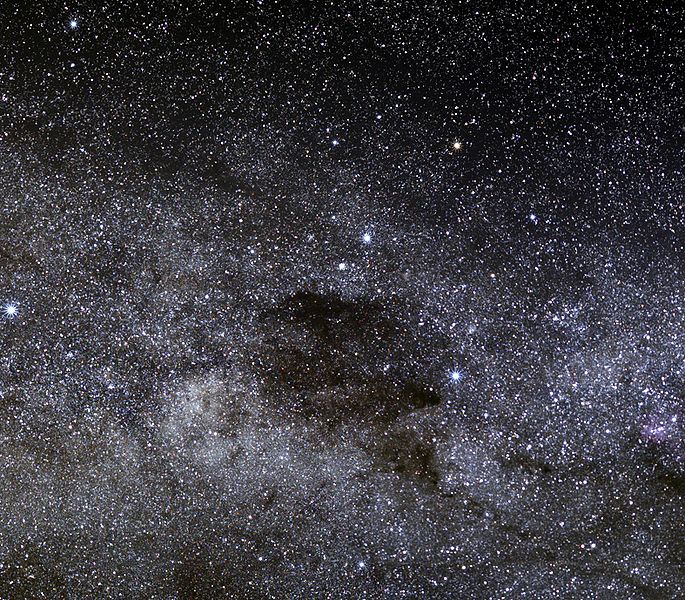Datei:Coalsack-ESO-B06.jpg

Originaldatei (1.574 × 1.378 Pixel, Dateigröße: 1,22 MB, MIME-Typ: image/jpeg)
![]()
Diese Datei und die Informationen unter dem roten Trennstrich werden aus dem zentralen Medienarchiv Wikimedia Commons eingebunden.
Beschreibung
| BeschreibungCoalsack-ESO-B06.jpg |
English: The Coalsack is one of the most prominent dark nebulae visible to the unaided eye. A beautiful sight in the southern sky, the Coalsack casts a dark silhouette against the Milky Way’s bright stripe of stars. The Coalsack is located approximately 600 light-years away from Earth in the southern part of the constellation of Crux (the Southern Cross).
This seemingly starless dark patch is actually an opaque interstellar dust cloud that obscures the light of the background Milky Way stars. Dust grains in the cloud redden the starlight that reaches us by absorbing blue light preferentially, so that the red stars shimmering in the northern and darkest part of the Coalsack appear more crimson than they would in the absence of this dust. The first European to see this remarkable object was probably the Spanish navigator and explorer Vincente Yanez Pinzon when he sailed to the South American coast in 1499. The Coalsack earned the nickname "Black Magellanic Cloud” in the 16th century, apparently rivalling the prominence of the Large and Small Magellanic Clouds, the two dwarf irregular galaxies that shine brightly in the skies of the Southern Hemisphere. The Incas tell that the god Ataguchu, in a fit of temper, kicked the Milky Way and a fragment flew off, forming the Small Magellanic Cloud where it landed on the sky, and leaving the black mark of the Coalsack behind. Beware of Inca gods in a bad mood! Another famous sight seen from southern latitudes — though it can creep into view in tropical northern latitudes — is the Southern Cross, or Crux. This cross-shaped constellation has assumed great significance in the cultures of the Southern Hemisphere, even as far back as prehistoric times. So distinctive and evocative is the Southern Cross that the national flags of Australia, Brazil, New Zealand, Papua New Guinea, and Samoa all include a representation of it. The European Southern Observatory (ESO) has also acknowledged the significance of Crux as the foremost constellation of the southern skies, and has proudly incorporated the cross-shaped symbol into the ESO logo. Its Mapudungun name (that is, in the language of the native Chilean Mapuche population), Melipal, was given to the third Unit Telescope of the VLT on Paranal. |
| Quelle | http://www.eso.org/gallery/v/ESOPIA/Nebulae/B06.tif.html |
| Urheber | ESO/S. Brunier |
| Andere Versionen | http://www.eso.org/gallery/d/121623-3/B06.tif |
 |
This media was created by the European Southern Observatory (ESO).
Their website states: "Unless specifically noted, the images, videos, and music distributed on the public ESO website, along with the texts of press releases, announcements, pictures of the week, blog posts and captions, are licensed under a Creative Commons Attribution 4.0 International License, and may on a non-exclusive basis be reproduced without fee provided the credit is clear and visible." To the uploader: You must provide a link (URL) to the original file and the authorship information if available. |
Diese Datei ist lizenziert unter der Creative-Commons-Lizenz „Namensnennung 4.0 international“.
| |
Lizenz
- Dieses Werk darf von dir
- verbreitet werden – vervielfältigt, verbreitet und öffentlich zugänglich gemacht werden
- neu zusammengestellt werden – abgewandelt und bearbeitet werden
- Zu den folgenden Bedingungen:
- Namensnennung – Du musst angemessene Urheber- und Rechteangaben machen, einen Link zur Lizenz beifügen und angeben, ob Änderungen vorgenommen wurden. Diese Angaben dürfen in jeder angemessenen Art und Weise gemacht werden, allerdings nicht so, dass der Eindruck entsteht, der Lizenzgeber unterstütze gerade dich oder deine Nutzung besonders.
Kurzbeschreibungen
In dieser Datei abgebildete Objekte
Motiv
image/jpeg
677ddf0bd0a582c8303e495187a5db6b7cce9b5f
1.284.442 Byte
1.378 Pixel
1.574 Pixel
Dateiversionen
Klicke auf einen Zeitpunkt, um diese Version zu laden.
| Version vom | Vorschaubild | Maße | Benutzer | Kommentar | |
|---|---|---|---|---|---|
| aktuell | 16:58, 21. Nov. 2009 |  | 1.574 × 1.378 (1,22 MB) | wikimediacommons>Fabian RRRR | {{Information |Description={{en|1=The Coalsack is one of the most prominent dark nebulae visible to the unaided eye. A beautiful sight in the southern sky, the Coalsack casts a dark silhouette against the Milky Way’s bright stripe of stars. The Coalsack |
Dateiverwendung
Die folgende Seite verwendet diese Datei:
Metadaten
Diese Datei enthält weitere Informationen (beispielsweise Exif-Metadaten), die in der Regel von der Digitalkamera oder dem verwendeten Scanner stammen. Durch nachträgliche Bearbeitung der Originaldatei können einige Details verändert worden sein.
| _error | 0 |
|---|